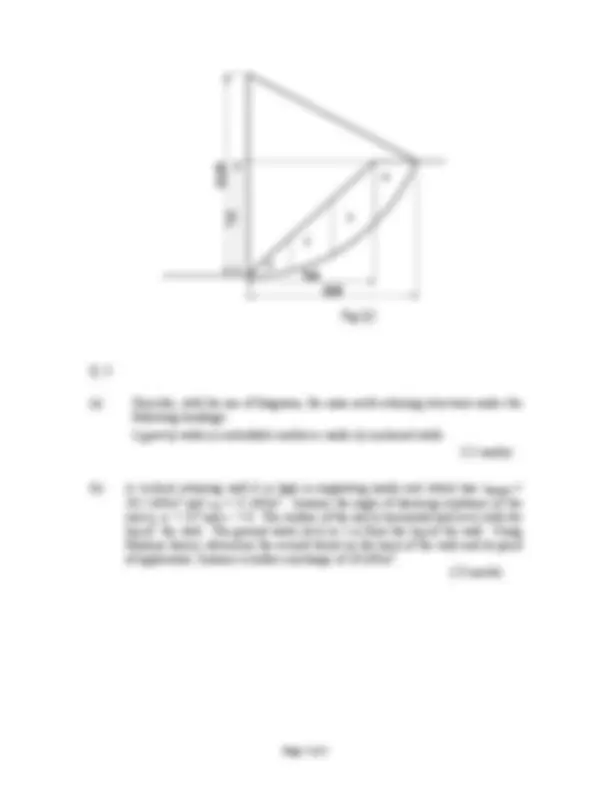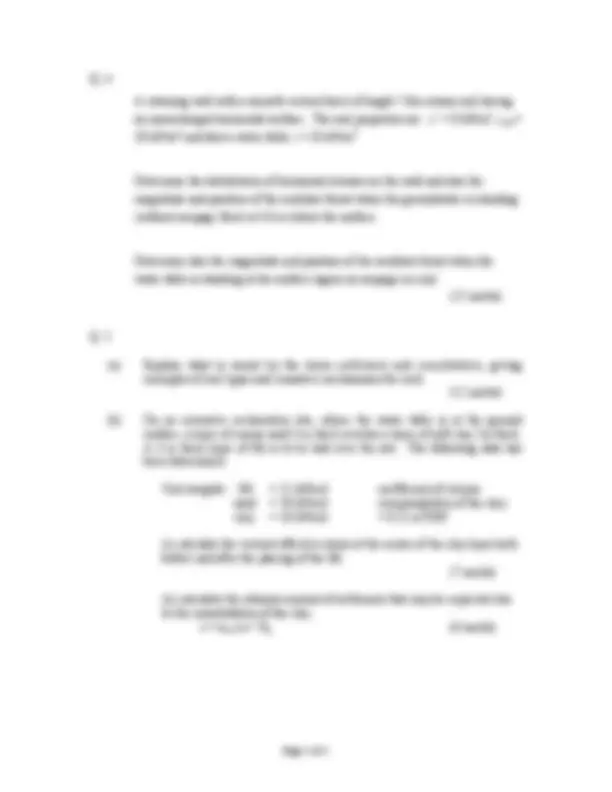




Study with the several resources on Docsity

Earn points by helping other students or get them with a premium plan


Prepare for your exams
Study with the several resources on Docsity

Earn points to download
Earn points by helping other students or get them with a premium plan
Community
Ask the community for help and clear up your study doubts
Discover the best universities in your country according to Docsity users
Free resources
Download our free guides on studying techniques, anxiety management strategies, and thesis advice from Docsity tutors
A past examination paper from the cork institute of technology for the module geotechnical engineering, part of the b.eng in civil engineering programme. Instructions for the examination, four questions related to geotechnical engineering problems, and useful formulae for solving the problems. The questions cover topics such as determining lateral active thrust on a retaining wall, slip circle analysis, earth retaining structures, and settlement and consolidation.
Typology: Exams
1 / 4

This page cannot be seen from the preview
Don't miss anything!



Autumn Examinations 2008/
Module Code: CIVL
School: Civil, Structural and Environmental engineering
Programme Title: B.Eng in Civil Engineering
Programme Code: CCIVL_7_-Y
External Examiner(s): Mr. J. Kindregan, Mr. J. Lapthorne
Internal Examiner(s): Ms. N. Hurley
Instructions: Answer FOUR questions, all questions carry equal marks
Duration: Two hours
Sitting: Autumn 2009
Requirements for this examination:
Note to Candidates: Please check the Programme Title and the Module Title to ensure that you are attempting the correct examination. If in doubt please contact an Invigilator.
The back of a retaining wall is inclined at 75º to the horizontal and has a vertical eight of 8.5m. The surface of the supported soil slopes upward from the top of the wall at an angle of 15º. The soil properties are c’= 0 kN/m^2 , φ ’ = 30º, γ = 20 kN/m^2 , δ = 25º
Determine the lateral active thrust imposed on the wall due to a trial wedge of soil having failure planes of 50º, 55º and 60º.
(25 marks)
W__________ Useful formulae: PA = sin (α – δ) cos (α – δ) + tan (θ – φ )
W = ½ γ sin (α + β). AB. AC
AC = AB sin (α + θ) / sin (θ – β)
(a) When would a total stress analysis (undrained stability) be applied to a slope stability analysis? (5 marks)
(b) In what cases would drained stability analysis be utilised?
(5 marks)
(c) Fig Q2, overleaf, shows the details of the cross section of an embankment slope.
For the slip circle shown, determine the factor of safety, assuming no pore pressure.
A retaining wall with a smooth vertical back of height 7.0m retains soil having an unsurcharged horizontal surface. The soil properties are : c’ = 0 kN/m^2 , γsat = 20 kN/m^3 and above water table γ = 18 kN/m^3.
Determine the distribution of horizontal stresses on the wall and also the magnitude and position of the resultant thrust when the groundwater is standing (without seepage flow) at 3.0 m below the surface.
Determine also the magnitude and position of the resultant thrust when the water table is standing at the surface (again no seepage occurs) (25 marks)
(a) Explain what is meant by the terms settlement and consolidation , giving examples of soil types and causative mechanisms for each (12 marks)
(b) On an extensive reclamation site, where the water table is at the ground surface, a layer of coarse sand 4 m thick overlies a layer of soft clay 5m thick. A 3 m thick layer of fill is to be laid over the site. The following data has been determined:
Unit weights: fill = 21 kN/m3 coefficient of volume sand = 20 kN/m3 compressibility of the clay clay = 18 kN/m3 = 0.22 m^2 /MN
(i) calculate the vertical effective stress at the centre of the clay layer both before and after the placing of the fill. (7 marks)
(ii) calculate the ultimate amount of settlement that may be expected due to the consolidation of the clay. s = mv ∆ σ’ Ho (6 marks)